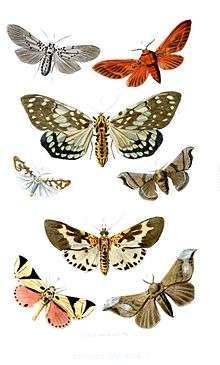Bombyx mandarina
| Wild silkmoth | |
|---|---|
 | |
| No. 5 | |
| Scientific classification | |
| Kingdom: | Animalia |
| Phylum: | Arthropoda |
| Class: | Insecta |
| Order: | Lepidoptera |
| Family: | Bombycidae |
| Genus: | Bombyx |
| Species: | B. mandarina |
| Binomial name | |
| Bombyx mandarina (Moore, 1872) | |
| Synonyms | |
|
Bombyx mori mandarina (Moore, 1872) | |
Bombyx mandarina, the wild silkmoth, is an insect from the moth family Bombycidae. It is the closest relative of Bombyx mori the domesticated silkmoth or "silkworm" (properly, this refers to the caterpillars only). Unlike the domesticated relative which is unable to fly or indeed persist outside human care, the wild silkmoth is a fairly ordinary lepidopteran. Its main difference from the domesticated taxon is the more slender body with well-developed wings in males, and the dull greyish-brown color.
Phylogeny and systematics
Together, the two species constitute the genus Bombyx, the true or mulberry silkmoths. The origin of the domesticated silkmoth is enigmatic. It has been suggested that it is the survivor of an extinct species which diverged from the ancestors of Bombyx mandarina millions of years ago. However, this is based on an untenable molecular clock hypothesis that assumes that wild and domestic silkmoths evolved equally fast after their lineages diverged. Rather, the effects of artificial selection have accelerated evolution in the domestic form to a point where it is hard to trace the origin of the numerous breeds of domestic silkworms even with the most modern molecular phylogeny methods.[1] Conceivably, today's domesticated silkworms are all descended from an initial stock of B. mandarina collected as late as 5000 years ago.[2] While wild silk could have been collected and used as threads, etc., since much earlier, the technology to breed and use silkworms from a domesticated stock did not exist before the late Neolithic.
However, it has been possible to trace the geographical origin of the domestic silkmoth. The wild species occurs over a considerable range from inland China to Korea and Japan, and shows much (albeit subtle) variation. The populations from the northeastern end of the range, for example, differ in karyotype from those of inland China. Domestic silkmoths are closer to the latter regarding mtDNA sequence data, and especially lack some genetic apomorphies of the northeastern B. mandarina. Thus, the initial domestic stock came from inland China.[3][4]
B. mandarina is able to hybridize with B. mori. Both in the wild and in a domesticated environment, females release pheromones and wait for males to be attracted and fly to them. However, B. mori males cannot fly. Hybridisation in the wild, therefore, inevitably means breeding between domestic (B. mori) females and wild (B. mandarina) males. Hybridization is possible in both directions in a domesticated environment.
Consequently, the two silkmoths have been united as subspecies of a single species; in this case the name Bombyx mori which was published first applies for both. However, today it is usually recognized that the domesticated silkmoth is entirely dependent on human care for its survival and thus has a level of reproductive isolation from its wild relatives.
References
- ↑ Yoshitake, N. (1968): Phylogenetic aspects on the origin of Japanese race of the silkworm, Bombyx mori L.. Journal of Sericological Sciences of Japan 37: 83–87.
- ↑ Yoshitake 1968
- ↑ Yukuhiro, K.; Sezutsu, H.; Itoh, M.; Shimizu, K. & Banno, Y. (2002): Significant Levels of Sequence Divergence and Gene Rearrangements have Occurred Between the Mitochondrial Genomes of the Wild Mulberry Silkmoth, Bombyx mandarina, and its Close Relative, the Domesticated Silkmoth, Bombyx mori. Molecular Biology and Evolution 19(8): 1385–1389. PDF fulltext
- ↑ Arunkumar, K.P.; Metta, Muralidhar & Nagaraju, J. (2006): Molecular phylogeny of silkmoths reveals the origin of domesticated silkmoth, Bombyx mori from Chinese Bombyx mandarina and paternal inheritance of Antheraea proylei mitochondrial DNA. Molecular Phylogenetics and Evolution 40(2): 419–427. doi:10.1016/j.ympev.2006.02.023 (HTML abstract). Supplementary figure 1 (JPG) Supplementary figure 2 (JPG) Supplementary figure 3 (JPG)
External links
- Japanese moths: Bombyx mandarina. Contains many photos. Retrieved 2007-JUL-18.
- Copulation between female B. mandarina (left) and male B. mori in captivity. Note stunted wings of male. Retrieved 2007-JUL-18.
| Wikispecies has information related to: Bombyx mandarina |